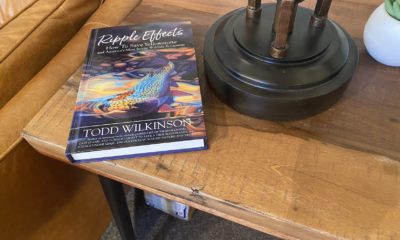Uncategorized
The New West: Jarvi’s “African Menagerie” shows how art can move the masses
Published
7 years agoon
Posted By
Outlaw Partners


CREDIT: David J Swift
By Todd Wilkinson EBS Environmental Columnist
Normally, encounters with fine art are personal affairs. Paintings might hang in museum galleries, attracting long lines of people but when they stir the soul, they do it one viewer at a time.
Never before had I witnessed a large crowded auditorium erupt spontaneously into a standing ovation with an unveiling of “wildlife art.”
But it happened last weekend in Grand Rapids, Minnesota when artist Brian Jarvi gave more than 700 people a sneak preview of his epic new masterpiece “African Menagerie: In Inquisition.”
I’ve been writing about wildlife art for three decades. One of the main criticisms—valid in my opinions—is that, yes, the genre has talented painters and sculptors very good at making pretty, superficial portrayals of animals but so few produce works that force us to think.


However, the greatest impact is one that transcends physical dimensions. Jarvi’s intent is to engage us with an existential question: Are 21st century humans doing enough to preserve the richness of biodiversity we now hold in our hands?
While “African Menagerie” is unprecedented as a work of modern wildlife art, it historically follows in the tradition of other narrative paintings that asked important social questions, such as Raphael’s “The School of Athens” located in the Vatican and Hieronymus Bosch’s triptych “The Garden of Earthly Delights” in Madrid’s Prado.
“African Menagerie,” too, is a grand narrative painting filled with dozens of coded visual messages. Jarvi’s overarching theme is wildlife conservation and the need for humans to be better stewards, but he isn’t delivering a lecture.
From the moment he conceived of African Menagerie years ago, he wanted it to be accompanied by the term “an inquisition,” meaning “a period of prolonged and intensive questioning or investigation.”
Known for his dramatic predators and prey scenes, Jarvi has been to Africa a dozen times on research trips yet part of his inspiration, he admits, came from visits made to Greater Yellowstone. He loves Big Sky.
Our region has an impressive abundance of species large and small, but whether here or halfway around the world, he’s not convinced we spend enough time reflecting on nature’s interconnections and, most importantly, how ecosystems are unraveling.
“I wanted to attempt a composition that had never been done before; that would bring the viewer inside a panorama where you can let your own imagination be your guide—to reflect and observe and feel the same sense of humility and reverence that I do,” he says. “I wanted viewers to be able to see something new with every viewing and to let beauty open our minds to a new level of awareness.”
Cleverly, Jarvi draws us in by using the patterns, shapes and outlines of iconic species we instantly recognize—elephant, mountain gorilla, zebra, giraffe, Cape Buffalo, chimpanzee and two species of rhino (one of which is now extinct in the wild). From there our eyes float between dozens upon dozens of others, many of them imperiled. Not only does the colorful massing inspire awe but it makes clear the magnitude of what’s at stake.
“In other words, It is my hope viewers will open their minds to considering other creatures that are just as important in the big picture but often overlooked,” he says. “Seeing them represented in the larger kingdom of nature and then asking the viewer to wonder what would be missing were they removed from existence?”
The animals form a confluence around a figure that Jarvi has dubbed “omega-man” but this is not a meeting based upon reverence for Homo sapiens; instead it represents a moment in which wildlife demands that humankind explain its actions.
“By the decisions we are making and the causes we support, we’re creating a world where many of the subjects in “African Menagerie” might not be around in another 50 years,” Jarvi says. “I wanted to give these animals a voice and help elevate awareness about the threats to their survival but do it in a way that comes across, foremost, as a celebration. The challenges facing Africa are a symbol for the world.”
Todd Wilkinson, founder of Mountain Journal (mountainjournal.org), is author of “Grizzlies of Pilgrim Creek” about famous Greater Yellowstone grizzly bear 399 featuring 150 photographs by Tom Mangelsen, available only at mangelsen.com/grizzly. His profile of Montana politician Max Baucus appears in the summer 2017 issue of Mountain Outlaw and is now on newsstands.
The Outlaw Partners is a creative marketing, media and events company based in Big Sky, Montana.


Upcoming Events
november, 2024
Event Type :
All
All
Arts
Education
Music
Other
Sports
Event Details
Spanish Classes with World Language InitiativeThese unique, no cost Spanish classes are made possible by the contribution of Yellowstone Club
more
Event Details
Spanish Classes with World Language InitiativeThese unique, no cost Spanish classes are made possible by the contribution of Yellowstone Club Community Foundation (YCCF) and Moonlight Community Foundation (MCF). This class will focus on building a lifelong affinity for world languages and cultures through dynamic and immersive Communicative Language teaching models.
Beginner Class – Mondays and Wednesdays from 5:30-6:30 pm
Intermediate Class – Mondays and Wednesdays from 6:45- 7:45 pm
- Classes begin Oct.7, 2024 and run for 6 weeks
- Class size is limited to 12 students
- Classes are held in Big Sky at the Big Sky Medical Center in the Community Room
For more information or to register follow the link below or at info@wlimt.org.
Time
October 28 (Monday) 5:30 pm - December 4 (Wednesday) 7:45 pm
Location
Big Sky Medical Center - Community Room (2nd Floor)
Big Sky Medical Center - Community Room (2nd Floor)
Event Details
Spanish Classes with World Language InitiativeThese unique, no cost Spanish classes are made possible by the contribution of Yellowstone Club
more
Event Details
Spanish Classes with World Language InitiativeThese unique, no cost Spanish classes are made possible by the contribution of Yellowstone Club Community Foundation (YCCF) and Moonlight Community Foundation (MCF). This class will focus on building a lifelong affinity for world languages and cultures through dynamic and immersive Communicative Language teaching models.
Beginner Class – Mondays and Wednesdays from 5:30-6:30 pm
Intermediate Class – Mondays and Wednesdays from 6:45- 7:45 pm
- Classes begin Oct.7, 2024 and run for 6 weeks
- Class size is limited to 12 students
- Classes are held in Big Sky at the Big Sky Medical Center in the Community Room
For more information or to register follow the link below or at info@wlimt.org.
Time
November 4 (Monday) 5:30 pm - December 11 (Wednesday) 7:45 pm
Location
Big Sky Medical Center - Community Room (2nd Floor)
Big Sky Medical Center - Community Room (2nd Floor)
Event Details
Spanish Classes with World Language InitiativeThese unique, no cost Spanish classes are made possible by the contribution of Yellowstone Club
more
Event Details
Spanish Classes with World Language InitiativeThese unique, no cost Spanish classes are made possible by the contribution of Yellowstone Club Community Foundation (YCCF) and Moonlight Community Foundation (MCF). This class will focus on building a lifelong affinity for world languages and cultures through dynamic and immersive Communicative Language teaching models.
Beginner Class – Mondays and Wednesdays from 5:30-6:30 pm
Intermediate Class – Mondays and Wednesdays from 6:45- 7:45 pm
- Classes begin Oct.7, 2024 and run for 6 weeks
- Class size is limited to 12 students
- Classes are held in Big Sky at the Big Sky Medical Center in the Community Room
For more information or to register follow the link below or at info@wlimt.org.
Time
November 11 (Monday) 5:30 pm - December 18 (Wednesday) 7:45 pm
Location
Big Sky Medical Center - Community Room (2nd Floor)
Big Sky Medical Center - Community Room (2nd Floor)
Event Details
Spanish Classes with World Language InitiativeThese unique, no cost Spanish classes are made possible by the contribution of Yellowstone Club
more
Event Details
Spanish Classes with World Language InitiativeThese unique, no cost Spanish classes are made possible by the contribution of Yellowstone Club Community Foundation (YCCF) and Moonlight Community Foundation (MCF). This class will focus on building a lifelong affinity for world languages and cultures through dynamic and immersive Communicative Language teaching models.
Beginner Class – Mondays and Wednesdays from 5:30-6:30 pm
Intermediate Class – Mondays and Wednesdays from 6:45- 7:45 pm
- Classes begin Oct.7, 2024 and run for 6 weeks
- Class size is limited to 12 students
- Classes are held in Big Sky at the Big Sky Medical Center in the Community Room
For more information or to register follow the link below or at info@wlimt.org.
Time
November 18 (Monday) 5:30 pm - December 25 (Wednesday) 7:45 pm
Location
Big Sky Medical Center - Community Room (2nd Floor)
Big Sky Medical Center - Community Room (2nd Floor)









